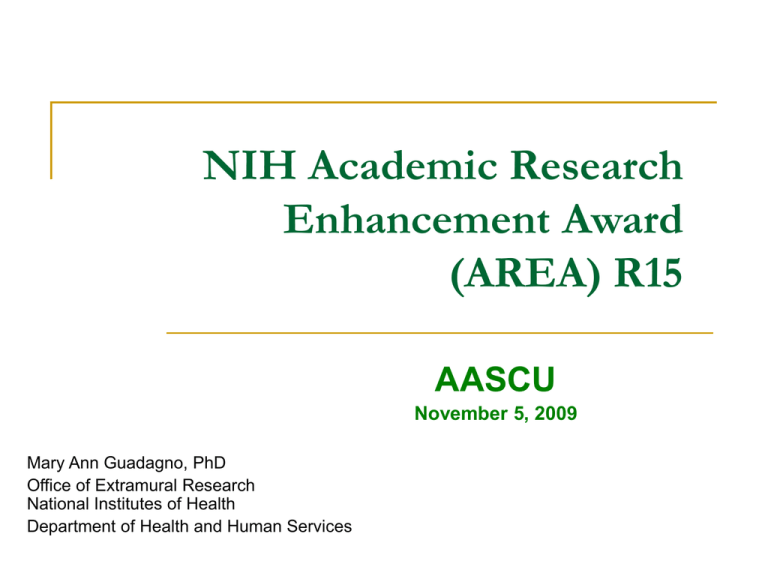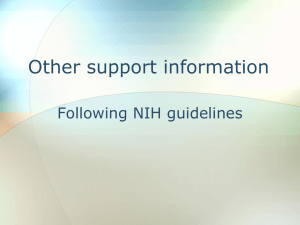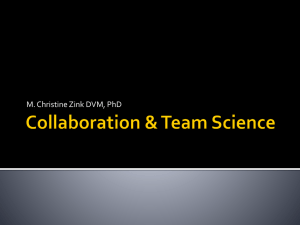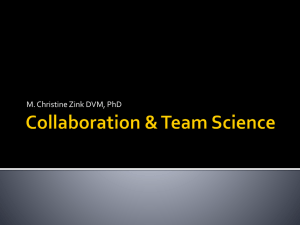Fundamentals of the NIH Grants Process
advertisement

NIH Academic Research Enhancement Award (AREA) R15 AASCU November 5, 2009 Mary Ann Guadagno, PhD Office of Extramural Research National Institutes of Health Department of Health and Human Services NIH Campus Today GOALS OF THE AREA PROGRAM Three main goals are: to support meritorious research, to strengthen the research environment of the institution, and to expose students to research. NIH Academic Research Enhancement Award (AREA) Eligibility limited to schools that have received less than $6 Million in NIH support (see /grants/funding/area.htm) Direct cost limited to $300,000 over entire project period Project period limited to up to 3 years Awards are renewable All NIH ICs utilize this mechanism except FIC an NCMHD Eligibility NIH considers the following to be health professional schools/colleges: School/College of Medicine, Veterinary Medicine, Podiatry, Nutrition, Dentistry, Osteopathy, Pharmacy, Public Health, Optometry, Nursing, Chiropractic Medicine, and Allied Health. All other NIH funding is considered “Other Academic.” When Preparing an Application Read instructions Never assume that reviewers “will know what you mean” Refer to literature thoroughly State rationale of proposed investigation Include well-designed tables and figures Present an organized, lucid write-up Obtain pre-review from faculty at your institution NIH Grant Writing Tips: http://grants.nih.gov/grants/grant_tips.htm What’s Changing? Restructured Applications to Align with Enhanced Review Criteria Research Plan (includes new terminology, “Research Strategy”) Resources Biographical Sketch New Page Limits for Research Strategy 12 page Research Strategy Additional 1 page for Specific Aims NIH Extramural Awarding Components National Cancer Institute (NCI) National Heart, Lung, and Blood Institute (NHLBI) National Institute of Diabetes and Digestive and Kidney Diseases (NIDDK) National Library of Medicine (NLM) National Institute of Child Health and Human Development (NICHD) National Institute of Deafness and Other Communication Disorders (NIDCD) National Institute of Environmental Health Sciences (NIEHS) National Institute of Neurological Disorders and Stroke (NINDS) National Institute on Aging (NIA) National Institute of Allergy and Infectious Diseases (NIAID) National Institute of Arthritis and Musculoskeletal and Skin Diseases (NIAMS) National Institute of Dental and Craniofacial Research (NIDCR) National Eye Institute (NEI) National Institute of General Medical Sciences (NIGMS) National Institute of Mental Health (NIMH) National Institute for Nursing Research (NINR) National Institute on Alcohol Abuse and Alcoholism (NIAAA) National Institute on Drug Abuse (NIDA) National Center for Complementary and Alternative Medicine (NCCAM) National Center for Research Resources (NCRR) National Human Genome Research Institute (NHGRI) National Institute of Biomedical Imaging and Bioengineering (NIBIB) The NIH Extramural Team Review Staff Grants Management Program Staff 2 Level System for Application Review 1st Level Scientific Review Group (SRG) Independent outside reviewers Evaluate scientific merit & significance Recommend length and level of funding 2nd Level National Advisory Council Assesses Quality of SRG Review Makes Recommendation to Institute Staff on Funding Evaluates Program Priorities and Relevance Advises on Policy Program Officer Roles Program Officials’ Role in Application Development Scientific Initiatives at ICs Develop concepts and Communicate goals Advise applicants on funding mechanisms, writing and technical assistance Advise on application procedures, requirements and general grant policy Program Officials’ Role at & After Review Meetings Attend and Observe Reviewers Enthusiasms and Concerns Discuss Summary Statements and Review Issues Raised with Applicants Advise on Resubmission Process Program Officials’ Role at Advisory Council Meetings Report and address any unresolved review concerns Human Subjects concerns and Animal Welfare Address requirements for foreign applications Program Officials’ Role in Funding Decisions Priority Score/Percentile Areas of Emphasis Portfolio Balance DATA for AREA Awards Fiscal Year 2008 NIH Institutes/Cent ers FY TOTAL Number of Applications Reviewed Number of Applications Awarded Award Amount2 Success Rate3 758 212 $44,172,133 28.0% 2007 FY TOTAL 862 216 $45,228,704 25.10% 2006 FY TOTAL 723 184 $37,938,780 25.40% 2005 FY TOTAL 661 197 $39,740,776 29% 2004 FY TOTAL 619 193 $37,633,031 31.20% 724.6 200.4 $40,942,685 27.7% Average AREA NEWS YOU CAN USE New updated PA-06-042 will be released in Fall – Due dates: Feb 25, June 25, Oct 25 Eligibility - $6 million Funding Level - $300,000 New page limit – 12 page Research Strategy Enhanced review criteria New rating system NIH Academic Research Enhancement Award (AREA R15 Grants) Additional Information AREA Webpage http://grants.nih.gov/grants/funding/area.htm Institutional Eligibility http://grants.nih.gov/grants/funding/area_ineligible.xls AREA Contacts http://grants.nih.gov/grants/funding/area_contacts.htm FAQs http://grants1.nih.gov/grants/funding/area_faq.htm SUCCESS Rates http://report.nih.gov/award/success/Success_Rate_AREA_1997-2007.xls NIH OFFICE OF EXTRAMURAL RESEARCH Office of Extramural Programs THANK YOU Questions ?







